Friday, September 30, 2005
Faro, Portugal

This door you can find on a house in Faro in the south in Portugal. Faro is the Algarve's capital and these days a gateway to the heavily-touristed southern coast of Portugal and also a thriving commercial centre, but surprisingly pleasant for all that. This is due to the fact that Faro has a rich history. It once was a trading post used by both Phoenicians and Carthaginians and became a major port under the Romans, who named it Ossonoba. Under the Moors, it became the cultured capital of a short-lived 11th-century principality founded by Mohammed ben Said ben Hárun, from whose name 'Faro' is said to have evolved. The town had it's share of destruction too. It was plundered and burnt down by the troops under the Earl of Essex, and the rebuilt Faro was shattered by an earthquake in 1722 and, except for its sturdy old centre, flattened by another the big quake in 1755. So the present city is mainly dated from the post-quake rebuilding. (Photo by
Francisco Ourique)
posted by /T/ at
9:07 AM


Wednesday, September 28, 2005
Dublin, Ireland

While staying in Dublin for a year, every day
Carol LeMouel passed this door on her busride. It's located at 46 Fitzwilliam Square in the center of Dublin. Fitzwilliam Square was named after the Fitzwilliam family, Earls of Merrion, who developed this land as part of their great estate on the southside of the Liffey. This, the most cohesive estate in Dublin was laid out between 1760 and 1850. The land acquired by the Fitzwilliam family was leased as a block from the City Corporation and as it was a single block, this lent it a cohesiveness that was lacking in the Gardiner Estate, which was developed and bought in small parcels. Their first project was Merrion Street in 1758. The door you see here is a fine example of Georgian Architecture and the timing of the photo in the beautiful fall colours was just perfect. Photo was sent in with
Carol LeMouel's approval by
Jennifer Hofmann.
posted by /T/ at
6:54 PM


Tuesday, September 27, 2005
Sofia, Bulgaria

This door photographed by
Raphael Cruz is actually a side door of the Aleksandar Nevski orthodox cathedral in Sofia, Bulgaria. This memorial church is considered to be one of the finest pieces of architecture in the Balkans and is definitely Sofia's number one attraction. The church was built in honour of the 200,000 Russian casualties of the War of Liberation in 1877–78 and was financed by public donations. Built between 1882 and 1924, It is a fabulous structure, with domes and half-domes and glitters with masses of gold leaf donated by the Soviet Union. The church has the capacity for 5000 worshipers and its services are magnificent, rich with incense, candlelight and resonate chanting.
posted by /T/ at
11:37 PM


Monday, September 26, 2005
Monsaraz, Portugal

After sending in a photo of
Monsaraz,
Monsaraz,
Monsaraz and
Monsaraz,
António Caeiro has shared with us a photo of... Monsaraz. This time no story about the town. But the links can help you refresh your memory. Enjoy!
posted by /T/ at
9:11 AM


Sunday, September 25, 2005
New Haven, CT
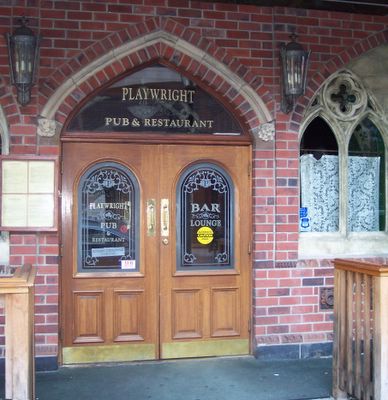
The Playwright Pub & Restaurant is located in New Haven across the street from the Omni New Haven Hotel at Yale. It was built in a renovated building by various members of the Guilfoyle family who are from Kilkenny, Ireland. Its decor is dominated by massive chunks of architecture rescued from ancient buildings in the British Isles. The main bar looks like a Gothic altar; the deejay booth is hidden behind a pulpit built in 1885; the arched windows on the building's facade once graced a chapel in Wales. When the Guilfoyles went on their trip to Brittain to find decorative architectural treasures in abandoned churches, cathedrals and schools for this bar, they rescued at least one sentimental artifact as well: the double doors to the Guilfoyles' great-grandparents' house, which they installed near the back bar and now affectionately refer to as "Granny's doors". (Photo by
Bill Owens)
posted by /T/ at
8:06 AM


Saturday, September 24, 2005
London, England
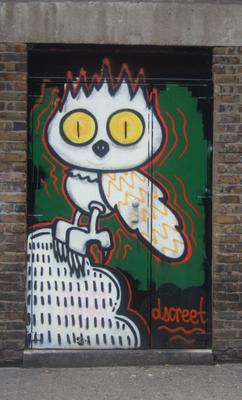
Brick lane in East London, also sometimes called Curry lane for it's many Indian restaurants or curry houses, played host to a festival that is hailed as one of the biggest and most important cross cultural street parties in all of England. The lane itself and the surrounding street is also a great place for photo opportunities. This door is just one of the many areas that have been colourfully decorate by the street artists. The photo was sent in by
Michelle Mitchell, England.
posted by /T/ at
6:52 AM


Tuesday, September 20, 2005
Monsaraz, Portugal

For those who have been following this blog for a while know that when there is a door from Monsaraz, Portugal it must be sent in by
António Caeiro. And they are right. António sent in this beautiful door from Monsaraz.
This small hilltop town of Monsaraz used to help guard against a Spanish section of the River Guadiana. The town came to prominence when it was captured from the Moors in 1167 by the famous soldier Geraldo Sem-Pavor (the Fearless). He improved the fortifications and gave the place to the militant Templar Order. It continued to suffer later many unsuccessful attacks from the invading Spanish throughout the following centuries. However, it was sacked in 1381 by the Earl of Cambridge when his proposed marriage to the daughter of Dom Fernando I was annulled and as a result he unleashed his anger on the town. His manner of gaining easy entry into the unassailable castle can be suspected as having pretended to still having enjoyed the favours of the Portuguese King.
posted by /T/ at
5:07 PM


Monday, September 19, 2005
Portola Valley, CA

Hidden in the small town of Portola Valley you can find the Our Lady of the Wayside Church where this is the entrance of. Built in 1912, Our Lady of the Wayside was designed by native San Francisco architect Timothy L. Pflueger (1892-1946) and built when he was only twenty years old! An awareness of the Spanish California missions inspired the style, which contrasts with the large commercial buildings and art deco theaters for which Pflueger later became notable.
In 1989, the Loma Prieta earthquake literally shook the church building to its foundations. Due to obvious structural damage, the Archdiocese was forced to close the church immediately. The structural engineers who assessed the severity of the damage and strongly recommended tearing down the existing building and replacing it with a new structure. A lot of the damage resulted from the very poor concrete used in the original construction. The parish community felt otherwise; for instead it raised $600,000 required to retrofit and repair this beloved church.
(Photo was taken less than an hour before I posted this)
posted by /T/ at
5:19 PM


Sunday, September 18, 2005
Saratoga, CA
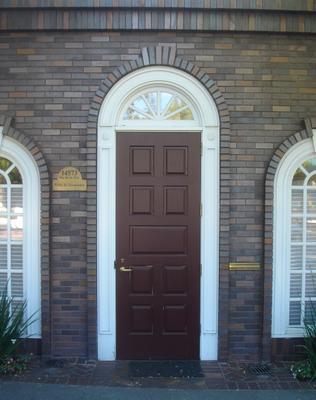
This door doesn't get the first price in a beauty contest, but it is a door that fits this town Saratoga. This city has a history of going with the latest trend instead of having it's own identity. The area was first inhabited by Indians who had built their homes near the mouth of the canyon at what an early map noted as
Campbell's Gap. Then in 1850-51, when Martin McCarty, who had leased a sawmill, built a toll road connecting it to the village, this site was called
Toll Gate. A post office was built in 1855 and got the name
McCartysville. In the industrial heyday a few factories were built here and the post office was named
Bank Mills in 1863. Later -with the discovery of mineral springs with a content similar to that of Congress Spring at Saratoga Springs, New York- it was renamed to
Saratoga. I wonder what the next name change will be since it is nicely located at the edge of Silicon Valley.. how about
Googleville?
posted by /T/ at
8:47 AM


Saturday, September 17, 2005
Fira, Santorini (Θηρα, Σαντορινη), Greece

Santorini is a crescent shaped volcanic island, that has gotten its shape by the eruption in 1,650 B.C. that was one of the largest eruptions in the last 10,000 years. About 7 cubic miles (30 cubic km) of rhyodacite magma was erupted, and causing the volcano to collapse leaving behind the island of Santorini with a few smaller ones on the other side of the caldera. It is believed that this eruption even caused the end of the Minoan civilization on the island of Crete south of Santorini. The town of Fira perches on the inside of the crater on top of the clif. And this door opens to stairs, in the open air, leading down into a taverna or small restaurant named "
Archipelagos" on the side of the cliff overlooking the caldera. The restaurant is one of the oldest captain's houses, built in 1860 and restored according to the traditional architecture. Photo by
Molly St.Cyr-Reid.
posted by /T/ at
12:58 AM


Friday, September 16, 2005
San Carlos, CA

This is the front door of one of the four buildings named Hacienda Gardens, on San Carlos Ave in San Carlos. The Hacienda Gardens were built in 1931 as residences in a beautiful mission style completely restored to now serve as office space. San Carlos has a history that goes back to the first known inhabitants, the Ohlone Indians. Life abruptly and dramatically changed for the native people, when Spanish military and civilian settlers arrived. But it took some few centuries before the City of San Carlos was founded. With the coming of the railroad, three attempts were made to develop a town. First, in 1888, the San Carlos Land Company tried to subdivide and sell lots on the lands once owned by T.G. Phelps. In 1907, the San Carlos Park Syndicate used an elaborate sales campaign to try to make San Carlos a second Hillsborough, calling the area Oak Park. Mr. Frederick Drake, of the Mercantile Trust arrived in 1917, taking over the San Carlos Park Syndicate. He was more successful in developing San Carlos. He improved the water supply and piped water to the lots; he installed gas and electricity, and paved the streets. And at that time the Spanish style cottages were built.
posted by /T/ at
8:16 AM


Thursday, September 15, 2005
Ephesus, Turkey
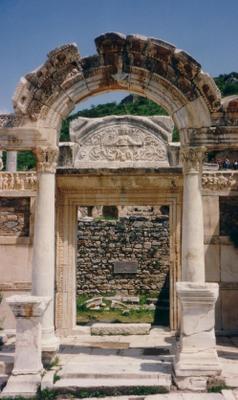
On the the street of the Curettes in Ephesus Turkey is the temple of Hadrian located where this is the front entrance of. This temple was constructed by P.Quintilius between 118-138 A.D., and dedicated to the emperor Hadrian. Prosperous, sophisticated, highly cultured, Ephesus was the leading city of the wealthy and populous Roman province of Asia and one of the most precious jewels in the Roman empire's crown. Today, the city of Ephesus stands as it did in ancient times. No modern city was ever built over it; once the emperor stopped the funds used to dredge the harbor, it gradually filled with silt and became unusable and so it lost its commercial value and its standing as a vital urban center. Photo was sent in by
Jennifer Hofmann.
posted by /T/ at
8:05 AM


Wednesday, September 14, 2005
Barkhamsted, CT
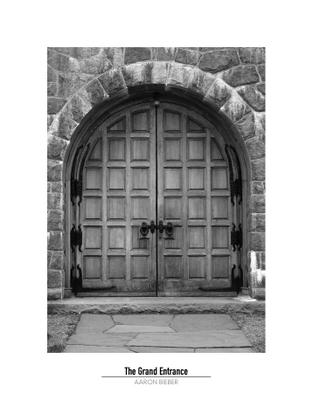
In yesterday's post I made a reference to this photo by
Aaron Bieber of the Saville Dam in Barkhamsted, CT. thinking that it was the same door, and was questioning where the differences came from. This door however is a different door than the one posted yesterday. This door is located down below the door that was posted yesterday, on the back face of the Saville Dam where there is a little park. It is amazing that a dam has such a beautiful doors when you think of how few people will enter any of these doors on a regular basis. According to the photographer of this door, who has visited many of the state parks with dams in Connecticut, the Saville Dam is by far the best maintained and most picturesque of all.
As with all photos on this blog, the photo was placed with permission of the photographer.
posted by /T/ at
7:02 AM


Tuesday, September 13, 2005
Barkhamsted, CT

This is the grand entrance to the gatehouse of the Saville Dam in Barkhamsted, CT (photo by
Bill Owens) that controls the water going down to the lake below the dam. And there is something surreal about this photo. In a B/W photo of 4/12/2004 by the photographer
Aaron Bieber there are quite a number of differences to be observed, from the stones on the bridge, to the detail of the wood and even the lamp above the door.
This dam was completed in 1940 on the East Branch of the Farmington River. It is named for the chief engineer of the project, Caleb Mills Saville. The Barkhamsted Reservoir is about 8 miles long and extends from central Barkhamsted north into the town of Hartland almost to Massachusetts. The Reservoir is the primary water supply for the metropolitan Hartford area, which is about 25 miles away. Many Barkhamsted farms, houses and the village of Barkhamsted Hollow were located in the area now flooded by the Reservoir.
posted by /T/ at
3:25 PM


Saturday, September 10, 2005
Front Door of the month: August
Today I announce you the second front door of the Month in the Front Doors' history. Last month was a tough choice, but this month it was even tougher. And because it was so close I will first announce that the runner up is Michelle Mitchell with her door of Antalya, Turkey. But the Jury announces that the Front Door of the month August 2005 is the Red door of the crypt of the St. Peters church in Streatham, London sent in by David Miller.

This photo was first placed on this Blog on
August 28th. Congratulations David I hope you will be sharing more of your beautiful photos with this blog in the future.
Please join me in congratulating
David Miller with his winning photo!!
This photo will be on display a few days while the editor of this blog take a short monthly pause. Keep sending in photos, your photo might become the next front door of the month.
P.S. We expect on Sunday, September 11, the 10.000st visitor since July 13, 2005 measured by Site Meter. Let me know if you are that special one!
posted by /T/ at
10:03 AM


Friday, September 09, 2005
London, England
 Michelle Mitchell
Michelle Mitchell took this photo in London at the Regent Street Summer Festival 5 days ago. As the restaurant marquee opens onto Regents Steet the door is being used to lure hungry mouths to their menu which has been strategically placed on the front door. The Regent Street Festival is held yearly and it is the only day that this busy street is traffic-free but changed into a musical and theatrical extravaganza.
Regent Street and the similarly named Regent's Park is one of London's prettiest areas. The neoclassical architecture of the park terraces was designed from plans laid in 1811 by John Nash, Crown Architect and friend of the Prince Regent. The park itself boasts over 400 acres of public space which includes playgrounds, landscaped gardens, an incredible Rose Garden with more than 150 species of roses and of course, the indomitable London Zoo.
posted by /T/ at
12:24 PM


Thursday, September 08, 2005
Póros, Greece
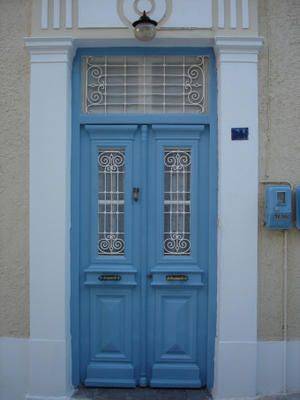
This front door you can find on the Greek island of Póros. Póros is a vulcanic island, that was named after the main town when it was formed by the bridge connection of the two islands, Kalouria (Kalavria), a larger and lusher island with green hills and beautiful coastlines, and Sphaeria (Sferia), a small rocky island. The town Póros on the island is built against the hills and is with it's blue white homes a true example of Greek architecture. At the center of the town is worth visiting the Archaeological museum and the island’s trademark the "clock-tower". This photo was taken by
Olivia Kallergi and sent in by her husband.
posted by /T/ at
11:34 AM


Wednesday, September 07, 2005
Sault Ste. Marie, Ontario, Canada
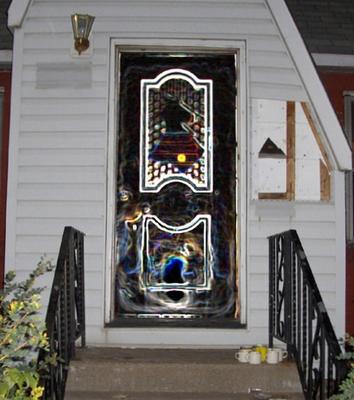
This "scary" door is the first Canadian door on this blog. Sault Ste. Marie's history was been moulded to a large extent by it's location on the banks of the St. Mary's River and its rapids. The shores of the rapids became a natural stopping point on any journey east or west. The construction of a canal and lock in 1895 to bypass the rapids provided an all-Canadian route from the Atlantic Ocean to the head of Lake Superior. The industrial empire created by Francis Hector Clergue spurred local development in the late 1890's and early 1900's. Directly, or indirectly, he created pulp and paper mills, hydro-electric plants, rail and marine transportation, mines and a steel plant. And it is close to this steel plant where they’ve emptied out and boarded up houses for demolition and wher you can find this house and it's creepy door. I hope not all Canadian doors are like this. This photo was sent in by
Mark Hohmann
posted by /T/ at
11:56 AM


Tuesday, September 06, 2005
Santa Cruz, CA

This is the front door of "The Prophet Elias Greek Orthodox Church" on 223 Church St. in Santa Cruz. It is often said that if you find one Greek in a town, you will find a restaurant; if you find two Greeks, you will also find a church. Well this church began very modestly in 1980 by borrowing space at Poor Clares, a Catholic church in Soquel. The Greek families' determination to found a church became a reality in 1982, when a building, that used to be a funeral home, was purchased and converted into Prophet Elias Greek Orthodox Church. Besides church services it hosts every year a Greek Festival with baklava sales and homemade treats created by the local Greek community. The
Greek Festival '05 will be held this coming weekend (September 9-11)!!
posted by /T/ at
9:55 AM


Monday, September 05, 2005
Roswell, NM

This door has been in my archive for a little while and I was wondering if I would post it or not. It was taken and sent in by
Stacie Nason. The interesting part here is not so much the door itself, but where the door is placed. This is the UFO that landed in Roswell New Mexico in 1947 (or that is what is believed). McDonald's cut out a part of the side, placed a regular boring McDonald's front door in it, and turned it into world's only extraterrestrial fast food restaurant.
posted by /T/ at
8:30 AM


Sunday, September 04, 2005
Caldas da Rainha, Portugal
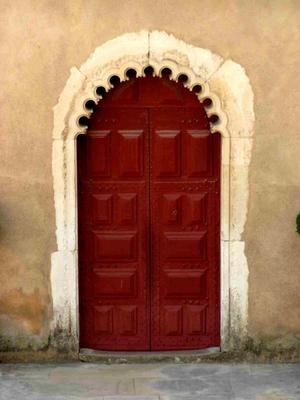
This gorgeous door is located in the city Caldas da Rainha (80km north of Lissabon) in Portugal. The city of Caldas da Rainha (Queen's Hot Waters), like the name suggests was founded by a queen. Leonor, wife of King Joao II. The construction of a Thermal Hospital and the setlement near it was her decision. One day, when going from Bidos to Batalha, to attend mass in honour of former king Afonso V, she saw several people bathing in water banks, fumegating and with an intense smell. Told that the water had healing properties she reportadly tried the waters herself, because she suffered from angina, a tumour or another unknown disease, and it aparently cured it her later on. So in sign of thanks for this, she decided to order the building of a hospital where the poor could seek a cure.
Foto by
Francisco Ourique
posted by /T/ at
1:15 PM


Saturday, September 03, 2005
Monsaraz, Portugal
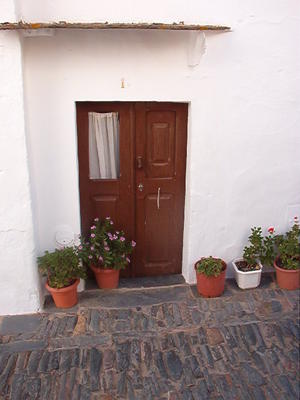
This door was sent in by
António Caeiro. Since the end of July he has been contributing some beautiful Portugese doors for this blog. His own blog is comletely dedicated to the beautiful little town Monsaraz which is one of the most beautifully preserved old towns in Portugal. Walking through Monsaraz is like taking a step back in time.
By the way, don't forget to
vote for the Front Door of the month August! Voting can be done throughout this coming week!
posted by /T/ at
9:17 PM


Friday, September 02, 2005
Final three of August
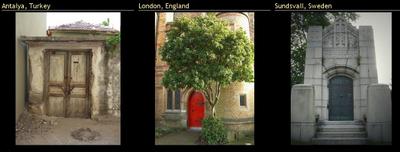
Time to reveal the final 3 for the month of August. And because we need a few more votes to determine the Front Door of the Month August, we encourage you to vote for 1 of these final 3 (in alphabetical order):
-
Antalya, Turkey-
London, England-
Sundsvall, SwedenMotivation of votes is highly encouraged. So bring it on!
posted by /T/ at
2:21 PM


Thursday, September 01, 2005
Front Door of the Month Nominees August 2005

Yes it's the first of the month, and for those who have been following this blog you would have figured out that today I have the honor to present the nominees for the front door of the month August 2005. These 6 doors were all posted the last month, and now I ask from you to tell me which door deserves the title Front Door of the Month.
The 6 nominees in alphabetic order are: 1.
Antalya, Turkey ; 2.
Cameron Highlands, Malaysia ; 3.
London, England ; 4.
New Haven, CT; 5.
Stockholm, Sweden ; 6.
Sundsvall, Sweden.
Tell me what you think!
posted by /T/ at
8:34 AM


 This door you can find on a house in Faro in the south in Portugal. Faro is the Algarve's capital and these days a gateway to the heavily-touristed southern coast of Portugal and also a thriving commercial centre, but surprisingly pleasant for all that. This is due to the fact that Faro has a rich history. It once was a trading post used by both Phoenicians and Carthaginians and became a major port under the Romans, who named it Ossonoba. Under the Moors, it became the cultured capital of a short-lived 11th-century principality founded by Mohammed ben Said ben Hárun, from whose name 'Faro' is said to have evolved. The town had it's share of destruction too. It was plundered and burnt down by the troops under the Earl of Essex, and the rebuilt Faro was shattered by an earthquake in 1722 and, except for its sturdy old centre, flattened by another the big quake in 1755. So the present city is mainly dated from the post-quake rebuilding. (Photo by Francisco Ourique)
This door you can find on a house in Faro in the south in Portugal. Faro is the Algarve's capital and these days a gateway to the heavily-touristed southern coast of Portugal and also a thriving commercial centre, but surprisingly pleasant for all that. This is due to the fact that Faro has a rich history. It once was a trading post used by both Phoenicians and Carthaginians and became a major port under the Romans, who named it Ossonoba. Under the Moors, it became the cultured capital of a short-lived 11th-century principality founded by Mohammed ben Said ben Hárun, from whose name 'Faro' is said to have evolved. The town had it's share of destruction too. It was plundered and burnt down by the troops under the Earl of Essex, and the rebuilt Faro was shattered by an earthquake in 1722 and, except for its sturdy old centre, flattened by another the big quake in 1755. So the present city is mainly dated from the post-quake rebuilding. (Photo by Francisco Ourique)
































